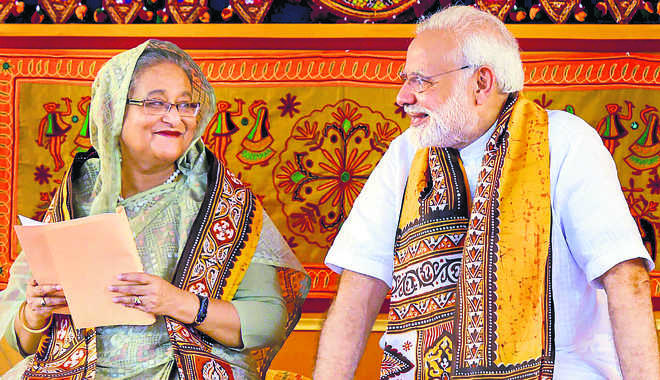
Reality check: Regional equation is changing; the ‘sphere of influence’ era is past.
MK Bhadrakumar
Former Ambassador
The victory of Prime Minister Sheikh Hasina’s Awami League in the parliamentary poll in Bangladesh was a foregone conclusion. Yet, the scale of the victory causes embarrassment. The Awami League’s grand alliance won 288 of the 299 seats in parliament, increasing its tally by 54 seats. Sheikh Hasina now joins a rare pantheon of democratically-elected leaders like Kim Jong-un. She could have done without the dubious honour, because she is doubtless a popular leader.
It remains a mystery why even charismatic politicians fear the mystique of elections. Probably, they regard themselves as indispensable. Sheikh Hasina’s government had a good record in executing the development agenda, and she could as well have emulated Indonesia’s Joko Widodo who is approaching the people for a renewed mandate in April. But she, instead, chalked up the landslide win by suppressing the opposition parties. The restrictive electoral environment and the crackdown on civil liberty, the opposition and the media have been widely reported. The government went to the extent of slowing down 3G and 4G Internet services in an attempt at censorship. Over half a million security personnel, including army soldiers, were deployed on ‘election duty’ to intimidate political opponents, giving a free run to Awami League activists at polling booths.
The really alarming part is the disdain with which Hasina has brushed away the criticism of her government. In an interview to the New York Times, she retorted, ‘If I can provide food, jobs and healthcare, that is human rights… What the opposition is saying, or civil society or your NGOs — I don’t bother with that.’ True, on Hasina’s watch, the GDP growth in Bangladesh increased from 5.57 per cent for 2009-2010 to 7.28 per cent in 2016-2017, and per capita income from $500 to nearly $1,800. But then, that is also India’s dismal story. The impressive growth largely benefited the elite. Make no mistake, there is a groundswell of protest building up in the country among workers, teachers and youth. Democracy is much more than about holding elections at regular intervals. Empowerment and inclusiveness are important prerequisites, and rule of law, freedom of opinion and pluralism are the lifeblood of democracy.
This is where India could have played a helpful role. Sensing the appalling drift in the democratic values, New Delhi could have used its influence with Hasina to counsel moderation. On the contrary, passivity replaced the frenzy that was apparent over the practice of democracy in the Maldives. If New Delhi went overboard to prescribe democratic values to the Maldives (country of half a million people), it went into hibernation with regard to Bangladesh (country with a population of 165 million.) Three things emerge here. One, it is about self-interest! Under the garb of democratic values, India pursues an interventionist policy in the neighbourhood to buttress its self-interest. Two, the interventionism as such is highly selective. India prescribes only to the weak and humble. Three, across the board, the ‘China factor’ has come to be the leitmotif of India’s neighbourhood policies.
The China factor merits particular attention. Bangladesh becomes a test case of the efficacy of Indian policies to curb the expanding Chinese influence in our region. Bangladesh has been the biggest recipient of Indian credit and aid since the Modi government came to power — an estimated $9 billion. However, this has not prevented the dramatic expansion of Bangladesh’s relations with China, especially since the state visit by President Xi Jinping in 2016, when Sheikh Hasina government officially joined the Belt and Road Initiative (BRI). Since then, the two countries have signed eight Chinese-funded projects estimated at $9.45 billion. China has factored in that Bangladesh’s sustained economic growth is rapidly increasing the demand for energy and transportation. Beijing has offered $30 billion for infrastructure investment as part of its massive BRI plans. Simply put, China has successfully dovetailed the BRI with Bangladesh’s development agenda.
The Bangladeshi paradigm ought to compel us to think through the phobia that whatever China is doing in the region is ‘India-centric’. China’s interests are increasingly global and there is growing evidence that it is moving toward a new phase of engagement that goes beyond dealings with individual countries to dealing with regions as a whole. In the excessive focusing on the ‘debt trap’ syndrome, we have overlooked that the BRI is actually about creating global standards and new value chains. According to figures released by the ministry of commerce in Beijing in August, there has been a massive expansion of China’s trade and investment ties with countries along the Belt and Road in the past five years, estimated to exceed $5 trillion, with China’s combined direct investment in those countries growing at 7.2 per cent annually. China has become the largest trading partner for 25 countries amongst them. Clearly, India lacks the ‘big picture’. The era of sphere of influence is long past.
Again, China’s financial support for other countries is based on pragmatic considerations. Take Latin America, the backyard of a superpower. Panama has emerged as the hub of China’s trade and logistics in the Americas. It is the regional headquarters of the Bank of China. The right-wing governments in Chile and Brazil are signalling interest in doing business with China. The salience here is that on a global scale China is de facto becoming the last-resort lender for countries that have limited access to international credit markets. Indeed, money talks in today’s globalised and multipolar world. The RSS recently praised Hasina as India’s ‘most trusted and tested ally’. Aren’t we losing the plot? If there is no SAARC, let us create one.



























